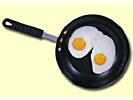When we first started cooking, we weren't sure what we needed in the kitchen. We bought what we needed, when we needed it. Over time, we've identified a number of key ingredients that continually show up in many of the dishes we cook, or at least in some of the dishes that we cook often. What we list here are not all of the various groceries we buy. Instead, we list the things that we buy so that we don't run out of it. Some of the items are perishable, others can be stored. In either case, you'll almost always find them in our kitchen.
Things that can be stored for a while:
- Cornstarch
- Soy sauce
- Salt
- Black peppercorns
- Finely ground white pepper
- Red chili pepper
- White wine
- Rice wine vinegar
- White vinegar
- Olive oil
- Sesame oil
- Chicken broth
- Garlic
- Ginger
- Rice
In many dishes, we cut some kind of meat into strips. It might be chicken, pork, or beef. Strips of meat will dry out while cooking unless one finds a way to sear them quickly and seal in the juices. We use a combination of cornstarch and either soy sauce or white wine to marinate our meat just before it goes into a pan with hot oil. What results is tender, flavorful meat. Cornstarch is useful for other things as well. It helps flakey fish filets stay together while pan-frying them with some ginger, scallions and soy sauce. It can be used as a thickening agent to make a gravy out of the drippings of a dish.
We rarely pour soy sauce directly into what we cook. If cooked for too long, soy sauce tends to give a bit of an unwanted sour taste. If a dish needs to be seasoned early, we tend to use salt instead of soy sauce. Soy sauce is mostly used in marinades and sauces or to finish a dish just as it is taken off of the heat -- it's good for pork chops, seafood porridge, steamed fish, and many other dishes that way.
We're big fans of pepper. Newly cracked black peppercorns add a lot of flavor when heated in oil before the other ingredients are added. For a milder flavor, we'll use white pepper instead. White pepper will show up more in soups and stews. We use crushed red chili pepper is many dishes, often even if it doesn't show up on a recipe. It's effective using the same technique as black pepper -- added to the oil before the other ingredients. Care should be taken though, because chili peppers can scorch, generating a noxious cloud of stinging smoke.
We use cheap bottles of white wine instead of cooking wine. There is probably little advantage to doing so since we tend to keep the opened bottle of white wine much longer than we should, but it is easier to control the salt level of a dish by using wine instead of cooking wine. Cooking wine often has salt added. The point of cooking with wine, though, is to get the flavor that remains after the alcohol burns off.
We don't use much vinegar in our cooking though we do keep two different kinds in stock. Rice wine vinegar is more mild than white vinegar. Both of them can be used to cut down a fishy smell, but then again, if your fish smells fishy, it may not be fresh, and you may want to reconsider eating it. Vinegar shows up in our Kung Pao chicken recipe, and in making sushi rice. Vinegar is cheap and it keeps a good long time.
Our oil of choice is olive oil, usually a pretty light pressing. Canola oil or vegetable oil has less flavor, but they would work fine in most of our cooking. Some people use peanut oil for some dishes to add even more flavor. We find that olive oil is a good compromise. We buy it in bulk, and use an oil dispenser. Sesame oil, on the other hand, is just used as a flavoring agent. It's used in Kung Pao chicken. It's useful in a dipping sauce for steamed dumplings. We even use it for flavor in seafood porridge.
Chicken broth forms the basis of many of the stews and soups that we cook. We buy the fat-free, reduced salt kind from Swanson, which has an easy-open pop top. We'll add it to dishes like split pea soup, and pork noodle soup with Szechwan pickles.
Garlic and ginger are simply used in too many dishes to not keep in stock. Most people keep garlic in a cool, dry place. We refrigerate ours. We're not sure why, but we've never had the problem of garlic going bad from being in the refrigerator. Why don't others keep it there? Update: as Albert points out, garlic supposedly loses flavor when refrigerated. This is also documented by Garlic Gal, who adds that garlic sprouts at 40o to 50o F. We don't know if we've had either problem, but we'll consider it.
Ginger on the other hand does have a tendency to dry out. It really shouldn't be listed among the items that don't perish -- it does. We just buy it in small enough quantities that it doesn't bother us when it does dry out. Some people have suggested crystallizing sugar on the exposed faces of the ginger, but we haven't tried that technique yet.
And rice? You have to have rice. Buy it in bulk, store it in the cupboard.
Perishable items that we also keep in stock:
- Mushrooms
- Green onions
- Spinach
- Tofu
- Chicken
- Carrots
- Eggs
We're not going to comment on each and every one of these ingredients. They just show up in many things we cook, so we tend to continue buying them, even if we don't know what we're going to make yet.

